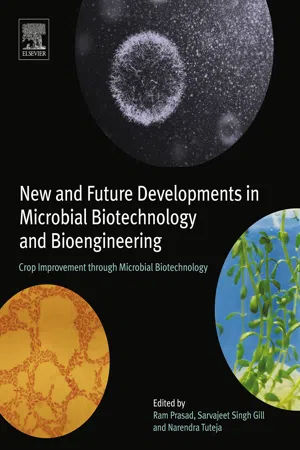
New and Future Developments in Microbial Biotechnology and Bioengineering
Crop Improvement through Microbial Biotechnology
- 496 pages
- English
- ePUB (mobile friendly)
- Available on iOS & Android
New and Future Developments in Microbial Biotechnology and Bioengineering
Crop Improvement through Microbial Biotechnology
About This Book
Crop Improvement through Microbial Biotechnology explains how certain techniques can be used to manipulate plant growth and development, focusing on the cross-kingdom transfer of genes to incorporate novel phenotypes in plants, including the utilization of microbes at every step, from cloning and characterization, to the production of a genetically engineered plant. This book covers microbial biotechnology in sustainable agriculture, aiming to improve crop productivity under stress conditions. It includes sections on genes encoding avirulence factors of bacteria and fungi, viral coat proteins of plant viruses, chitinase from fungi, virulence factors from nematodes and mycoplasma, insecticidal toxins from Bacillus thuringiensis, and herbicide tolerance enzymes from bacteria.
- Introduces the principles of microbial biotechnology and its application in crop improvement
- Lists various new developments in enhancing plant productivity and efficiency
- Explains the mechanisms of plant/microbial interactions and the beneficial use of these interactions in crop improvement
- Explores various bacteria classes and their beneficial effects in plant growth and efficiency
Frequently asked questions
Information
The Use of Microorganisms for Gene Transfer and Crop Improvement
† Ondokuz Mayıs University, Samsun, Turkey
‡ Sugar Institute, Ankara, Turkey
§ Abant Izzet Baysal University, Bolu, Turkey
Abstract
Keywords
1 Agrobacterium-Based Technologies
1.1 Gene Transfer Through Agrobacterium Tumefaciens

1.2 Gene Transfer Through Agrobacterium Rhizogenes
Table of contents
- Cover image
- Title page
- Table of Contents
- Copyright
- Contributors
- Chapter 1: The Use of Microorganisms for Gene Transfer and Crop Improvement
- Chapter 2: Actinomycetes as Potential Plant Growth-Promoting Microbial Communities
- Chapter 3: Microbial Genes in Crop Improvement
- Chapter 4: Microbial Transformations Implicit With Soil and Crop Productivity in Rice System
- Chapter 5: Application of Microbial Biotechnology in Food Processing
- Chapter 6: Innate Immunity Engaged or Disengaged in Plant-Microbe Interactions
- Chapter 7: Novel Strategies for Engineering Resistance to Plant Viral Diseases
- Chapter 8: Molecular Characterization of Sugarcane Viruses and Their Diagnostics
- Chapter 9: Cyanobacterial Biodiversity and Biotechnology: A Promising Approach for Crop Improvement
- Chapter 10: Pseudomonas fluorescens: A Plant-Growth-Promoting Rhizobacterium (PGPR) With Potential Role in Biocontrol of Pests of Crops
- Chapter 11: Crop Improvement Through Microbial Technology: A Step Toward Sustainable Agriculture
- Chapter 12: Microbial Technologies for Sustainable Crop Production
- Chapter 13: Trichoderma: Its Multifarious Utility in Crop Improvement
- Chapter 14: Microbe-Mediated Enhancement of Nitrogen and Phosphorus Content for Crop Improvement
- Chapter 15: Microbiome in Crops: Diversity, Distribution, and Potential Role in Crop Improvement
- Chapter 16: Plant Growth-Promoting Rhizobacteria (PGPR): Perspective in Agriculture Under Biotic and Abiotic Stress
- Chapter 17: Rhizosphere Metabolite Profiling: An Opportunity to Understand Plant-Microbe Interactions for Crop Improvement
- Chapter 18: Phosphate-Solubilizing Pseudomonads for Improving Crop Plant Nutrition and Agricultural Productivity
- Chapter 19: Targeted Genome Editing for Crop Improvement in Post Genome-Sequencing Era
- Chapter 20: Endophytic Microorganisms: Their Role in Plant Growth and Crop Improvement
- Chapter 21: Microbes in Crop Improvement: Future Challenges and Perspective
- Chapter 22: Plant-Microbe Interaction and Genome Sequencing: An Evolutionary Insight
- Chapter 23: Crop Breeding Using CRISPR/Cas9
- Chapter 24: Bioprospecting PGPR Microflora by Novel Immunobased Techniques
- Index